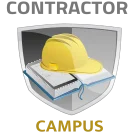Utah Boiler, Pipeline, Waste Water, and Water Conditioner (S410) Contractor License
The Utah Boiler, Pipeline, Waste Water, and Water Conditioner (S410) Contractor License allows you to do the following work:
- Placing and setting of screeds for pavement for flatwork
- Construction of forms, shoring material, placing and erection of bars for reinforcing and application of plaster and other cement-related products
- Excavation, grading, compacting, and laying of fill or other related base
- Painting or coating the surfaces, including striping, directional, and other types of symbols or letters
- Fabrication, construction, and installation of forms and shoring material
- Fabrication, construction, and installation of:
Pipes, conduit, or cables for the conveyance and transmission from one station to another of such products as:
- Water
- Steam
- Gases (except for natural gas, which requires an RMGA certificate holder to conduct the work)
- Chemicals
- Slurries
- Other substances
- Data or communications
- Geo-thermal systems
- Solar thermal systems (up to where the system interfaces with any other plumbing system)
Installation of:
- Above and below ground storage tanks
- Piping
- Dispensing equipment
- Monitoring equipment
- Associated temperature-control or other equipment for any petroleum
- Petro-chemical
- Water
- Steam
- Chemicals
- Slurries
- Oil
- Gases (except for natural gas, which requires an RMGA certificate holder to conduct the work)
- Other substances
- Insulation of pipes, ducts, and conduits
Work-related to the scope of practice:
- Excavation
- Cabling
- Horizontal boring
- Grading
- Trenching
- Backfilling
Fire-tube and water-tube power boilers and hot water heating boilers, including:
- Fittings and piping
- Valves
- Gauges
- Pumps
- Radiators
- Converters
- Fuel oil tanks
- Fuel lines
- Chimney flues
- Heat insulation and other devices
- Apparatus
- Equipment related thereto, in a system not connected to the culinary water system or connected to the culinary water system but separated from the culinary water system by a backflow prevention device
- Water conditioning equipment and only such pipe and fittings as are necessary for connecting the water conditioning equipment to the water supply system within the premises
Work on sewage systems:
- Sewer
- Sewer lines
- Sewage disposal
- Septic tank
- Drainage including excavation and grading with respect thereto
- Construction of sewage disposal plants and appurtenances thereto
- Incidental excavation, backfill, concrete or asphalt work related to the scope of practice
- The installation of a backflow preventer device if, during each renewal period after initial licensure, the licensee completes at least two of their six continuing education hours
- Shall hire or subcontract with an RMGA-certified licensed contractor for any natural gas-related work
How to Get the Boiler, Pipeline, Waste Water, and Water Conditioner (S410) Contractor License in Utah?
- Fill out the trade application form
- Apply online on My License E-Government
- Complete an approved 25-hour pre-licensure course from one of the following Utah-approved providers:
- Attain a General Liability Insurance Certificate with the minimum required coverage of $100,000 for each incident and $300,000 in total and where DOPL is listed as certificate holder
- Register your business entity with the Division of Corporations and Commercial Code
- Obtain a Federal Employee Identification Number (EIN) from the Internal Revenue Service (IRS)
- Acquire the following if the applicant has employees:
- Certificate of worker’s compensation insurance with the DOPL as the certificate holder
- Unemployment registration from the Utah Department of Workforce Services
- State withholding tax registration from the Utah State Tax Commission
- Obtain the following if the applicant does not have employees:
- Send the corresponding documents to:
DOPL
Heber M. Wells Building
160 East 300 South
P.O. Box 146741
Salt Lake City, UT 84114-6741 - Expect a response from the department in a 4 to 6-week period

